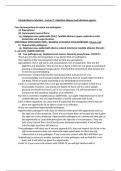Introduction to infection – lecture 1. Infectious disease and infectious agents.
Few microorganisms in nature are pathogenic:
(a) Saprophytes
(b) Commensals (normal flora)
eg. Staphylococcus epidermidis (skin), Candida albicans (upper respiratory tract)
Escherichia coli (Large intestine)
ADDITIONAL DOCUMENTATION / READING AVAILABLE ON BLACKBOARD: Please read
(c) Opportunistic pathogens
eg. Staphylococcus epidermidis (device related infections) Candida albicans (thrush);
E. coli (UTI): FRIEND AND FOE
(d) True pathogens eg. Staphylococcus aureus, Neisseria gonorrhoeae, COVID-19
There are very few microorganisms in our planet that are pathogenic.
The majority of the microorganisms that we find are saprophytes.
Saprophytes= live in soil and in and around plants. Live in organisms. They are the
digesters and dissolvers. They do not do us harm as they are not good at surviving at
growing at physiological temperatures. They find the environment that humans live
in not very accommodating.
Commensals= commensals find the environment that humans live in very
accommodating. Commensals include normal flora that we would expect to find in
our body. These are good at growing in our physiological environment.
E.Coli is a commensal that lives in our gut and therefore we can expect to find it in a
fecal sample. However, you should not expect to find e.coli in a urine sample
because we should not have E.coli in our urinary tract. If E.coli was present in our
urinary tract this would be indicative of an infection.
Our skin is covered in staphylococcus epidermidis, our upper respiratory tract is full of
candida albicans, and our large intestine is heavily colonized with E.coli.
Each of these organisms can cause harm if it gets into the wrong place and if they are
given the opportunity to be able to cause us an infection.
These are considered opportunistic pathogens.
Opportunistic pathogens= will cause an infection when given the opportunity such as
the right set of circumstances. These are our friends that can become our foe if given
the right set of circumstances. Opportunistic pathogens are commensals that give us
the opportunity to cause infections given the right set of circumstances. They are
part of our normal flora, that if we become immunocompromised, if we let them
into the right area they will infect us.
True pathogen= will infect you if you are exposed to it, does not require you to be in the
right environment it does not require the right opportunity to infect you. Eg.
Tuberculosis is a true pathogen. If you come into contact with TB it will infect you.
Staphylococcus aureus is another example of a true pathogen, and we find this in our
body, but it will infect us given the opportunity.
Covid 19- if you come into contact with COVID-19 you will get infected with it.
, Definitions:
• Infection: process of microbial invasion eg. common cold, tonsillitis, urinary tract
infection, infected leg ulcer
• Infectious disease (communicable disease): infective diseases that are readily
transmitted from person to person eg. respiratory infections (eg TB, common cold,
COVID-19, gastrointestinal infections, sexually transmitted infections (STI)
• Gastrointestinal infections can be spread by faecal oral transmission.
Infection in the 21st century: developed nations
• Infectious diseases cause >25% of all deaths
• Infections of concern in the developed world:
(a) Pneumonia: HAP / CAP: UK deaths 30,000/PA
(b) Tuberculosis (10 million new cases) and drug-resistant TB (560,000 new cases)
globally
UK 2018: 4,672
(c) Gastrointestinal infections (norovirus, campylobacter; Clostridium difficile
(2018:13,286)
(d) Device-related infections (catheters, prosthetic joints)
(e) Healthcare associated infections (MRSA,
C. difficile, carbapenemase-producing G-ve)
(f) Sexually transmitted infection (chlamydia, gonorrhoea, syphilis, herpes, genital
warts, HIV)
• Infectious diseases cause >25% of all deaths
• Infections of concern in the developed world:
(a) Pneumonia: HAP / CAP: UK deaths 30,000/PA
(b) Tuberculosis (10 million new cases) and drug-resistant TB (560,000 new cases)
globally
UK 2018: 4,672
(c) Gastrointestinal infections (norovirus, campylobacter; Clostridium difficile
(2018:13,286)
(d) Device-related infections (catheters, prosthetic joints)
(e) Healthcare associated infections (MRSA,
C. difficile, carbapenemase-producing G-ve)
(f) Sexually transmitted infection (chlamydia, gonorrhoea, syphilis, herpes, genital
warts, HIV)
Nosocomial infection = infection you get from the hospital.
Factors facilitating the spread of infection in the 21st century: developed nations.
Ease of travel; ‘shrinking world’
Medical interventions (ageing population; increased surgery)
Overuse of antibiotics (antibiotic resistance; HAI)
Contraceptive pill (STIs)
Social: (alcohol, drugs, MSM, social networks: internet chat, geosocial networking
apps – linked with increase in STIs)




